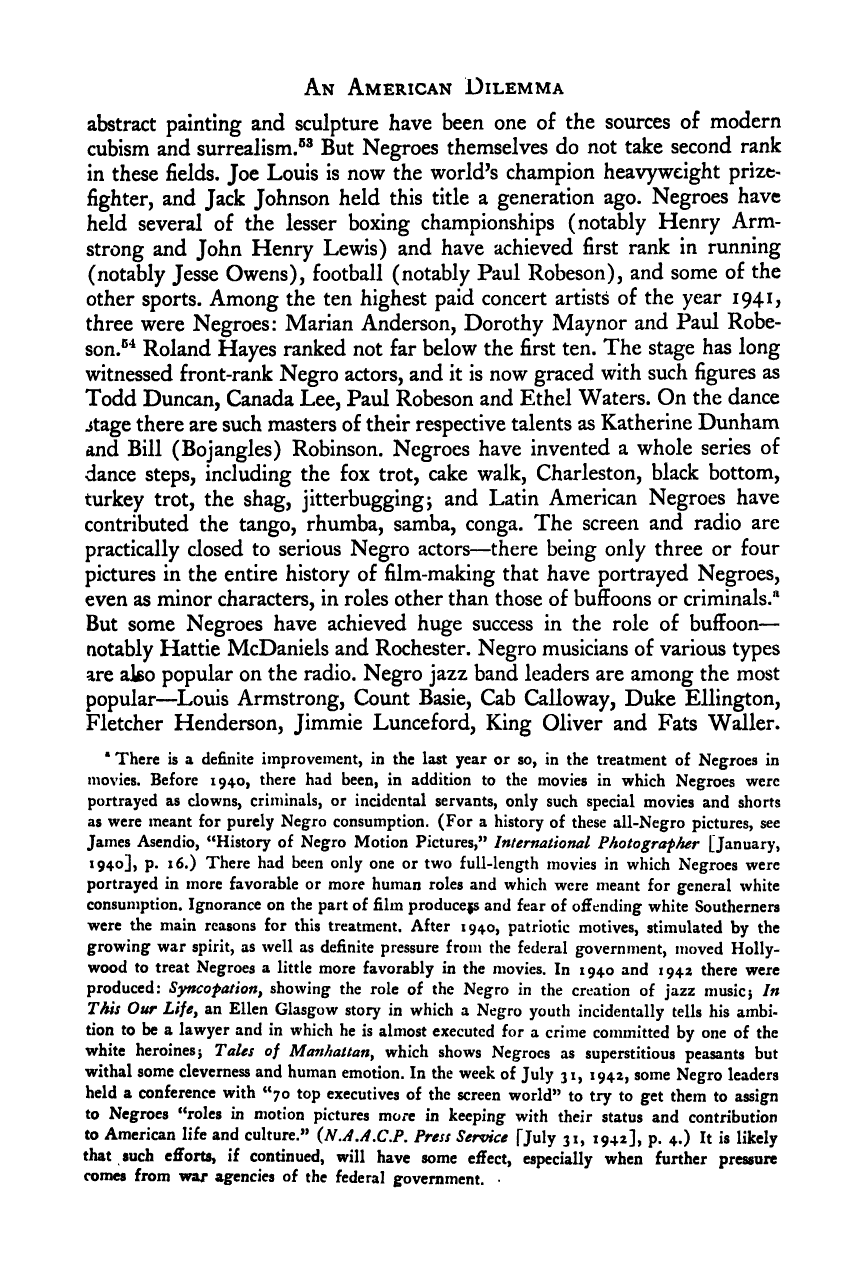Note: Gunnar Myrdal died in 1987, less than 70 years ago. Therefore, this work is protected by copyright, restricting your legal rights to reproduce it. However, you are welcome to view it on screen, as you do now. Read more about copyright.
Full resolution (TIFF) - On this page / på denna sida - X. The Negro Community - 44. Non-Institutional Aspects of the Negro Community - 5. Negro Achievements

<< prev. page << föreg. sida << >> nästa sida >> next page >>
Below is the raw OCR text
from the above scanned image.
Do you see an error? Proofread the page now!
Här nedan syns maskintolkade texten från faksimilbilden ovan.
Ser du något fel? Korrekturläs sidan nu!
This page has never been proofread. / Denna sida har aldrig korrekturlästs.
An American Dilemma
abstract painting and sculpture have been one of the sources of modern
cubism and surrealism.®^ But Negroes themselves do not take second rank
in these fields. Joe Louis is now the world^s champion heavyweight prize-
fighter, and Jack Johnson held this title a generation ago. Negroes have
held several of the lesser boxing championships (notably Henry Arm-
strong and John Henry Lewis) and have achieved first rank in running
(notably Jesse Owens), football (notably Paul Robeson), and some of the
other sports. Among the ten highest paid concert artists of the year 1941,
three were Negroes: Marian Anderson, Dorothy Maynor and Paul Robe-
son.®*^ Roland Hayes ranked not far below the first ten. The stage has long
witnessed front-rank Negro actors, and it is now graced with such figures as
Todd Duncan, Canada Lee, Paul Robeson and Ethel Waters. On the dance
jtage there are such masters of their respective talents as Katherine Dunham
and Bill (Bojangles) Robinson. Negroes have invented a whole series of
dance steps, including the fox trot, cake walk. Charleston, black bottom,
turkey trot, the shag, jitterbuggingj and Latin American Negroes have
contributed the tango, rhumba, samba, conga. The screen and radio are
practically closed to serious Negro actors—there being only three or four
pictures in the entire history of film-making that have portrayed Negroes,
even as minor characters, in roles other than those of buffoons or criminals."
But some Negroes have achieved huge success in the role of buffoon
—
notably Hattie McDaniels and Rochester. Negro musicians of various types
are also popular on the radio. Negro jazz band leaders are among the most
popular—^Louis Armstrong, Count Basie, Cab Calloway, Duke Ellington,
Fletcher Henderson, Jimmie Lunceford, King Oliver and Fats Waller.
There is a definite improvement, in the last year or so, in the treatment of Negroes in
movies. Before 1940, there had been, in addition to the movies in which Negroes were
portrayed as clowns, criminals, or incidental servants, only such special movies and shorts
as were meant for purely Negro consumption. (For a history of these all-Negro pictures, see
James Asendio, “History of Negro Motion Pictures,” International Photografher [January,
1940], p. 16.) There had been only one or two full-length movies in which Negroes were
portrayed in more favorable or more human roles and which were meant for general white
consumption. Ignorance on the part of film producefs and fear of offending white Southerners
were the main reasons for this treatment. After 1940, patriotic motives, stimulated by the
growing war spirit, as well as definite pressure from the federal government, moved Holly-
wood to treat Negroes a little more favorably in the movies. In 1940 and 1942 there were
produced: Syncopation^ showing the role of the Negro in the creation of jazz music }
In
This Our Life, an Ellen Glasgow story in which a Negro youth incidentally tells his ambi-
tion to be a lawyer and in which he is almost executed for a crime committed by one of the
white heroines j Tales of Manhattan^ which shows Negroes as superstitious peasants but
withal some cleverness and human emotion. In the week of July 31, 1942, some Negro leaders
held a conference with “70 top executives of the screen world” to try to get them to assign
to Negroes “roles in motion pictures more in keeping with their status and contribution
to American life and culture.” {N.A,A.C.P, Press Service [July 31, 1942], p. 4.) It is likely
that such efforts, if continued, will have some effect, especially when further pressure
comes from war agencies of the federal government. •
<< prev. page << föreg. sida << >> nästa sida >> next page >>